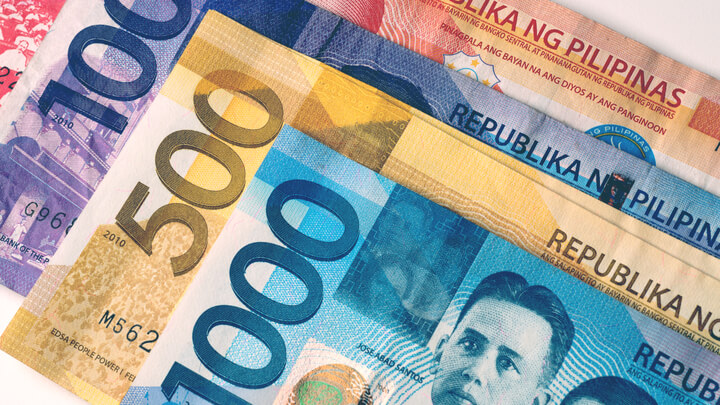Full guide to visas to the Philippines from the USA (2024)
In this article, navigate the tourist visa process to the Philippines from the USA. Discover insights & steps for a seamless application and travel experience.

Contributing over 10% of the nation’s GDP - tourism in the Philippines is a big deal. You can see why. The country is spread across over 7000 islands with awesome natural scenery that offer opportunities for diving, beach breaks and rainforest trekking. What more could you want in a vacation?
To make your dream trip a reality, you're going to need some cash.
This guide gives you all you need to know about the banking and currency systems in the Philippines. Find out how to get - and spend - your Philippine Pesos, so you can get on with planning your trip.
The currency used in the Philippines is the Philippine Peso.
In some tourist areas you might be able to pay for goods and services using U.S. dollars and euros. However convenient this may appear to be, unfortunately the exchange rates that are applied are unlikely to be great. Make sure you know what you're getting before you agree.
| Peso Symbols & Names | PHP, ₱ |
| 1 PHP | Each Peso is divided into one hundred Centavos. You might come across ‘Centavo’ spelled slightly differently (sintabo or sentabo) in some areas of the Philippines. |
| PHP Coins | Although Centavo coins (in 1, 5, 10, and 25 Centavo denominations) are still issued, they’re rarely used. In fact, there have been campaigns to remove these coins from circulation. You will, however, see 1, 5, and 10 Peso coins more frequently used. The 5 and 10 Peso coins are quite similar in design, so watch out when you're counting out your cash. |
| PHP Banknotes | Banknotes are issued in denominations of 20, 50, 100, 200, 500, and 1000 Pesos – although the 200 Peso note is not used so regularly. |
The banknotes used in the Philippines recently transitioned, meaning that two sets of notes were circulating with slightly different designs. By 2017, the older notes ceased to be legal, so it's best to make sure that any currency you are issued is from the new series.
It's worth doing your research before buying your pesos, as the exchange rates offered in Europe and North America are often not as good as those you’ll get on arrival. If you’re concerned about arriving in the Philippines without pesos in your pocket, then exchange a little before leaving, but don't forget to ask for a mixture of denomination notes. The first thing you’ll need your cash for will be a taxi - and drivers won’t have large amounts of change with them.
Many people exchange some cash in the airport - but check the rates you’re offered. Exchange services at places like airports and hotels aren’t usually very favourable due to the high rental costs which are then passed onto the customer.
For both convenience and a decent deal, you might be better to withdraw a small amount of cash from an ATM before exchanging the rest of your cash in town.
When choosing a currency exchange service, watch out for hidden fees. Even if an exchange claims ‘Zero Commission’, they still make a profit - generally by adding it into the poor exchange rate that they offer customers. The best way to pick out the fair deals from the bad ones is to understand the mid market rate.
The mid-market rate is the one used by the banks to trade currency between themselves - and this is the only real exchange rate. Tourist rates are derived from this mid market point by exchange services (who all use their own formula to come up with their individual exchange rates).
The difficulty is, that the mid-market rate is constantly fluctuating, so it can be difficult to keep up with. The easiest way is to use a currency converter online which will give you the live mid-market rate when you need to check it and find out whether or not a deal is fair.
If you're exchanging cash once you’ve arrived, make sure the notes you take are clean and crisp. Merchants won’t accept damaged or defaced notes, and often favour larger bills if you have them.
Many travellers have moved away from Traveller’s Checks in favour of ATM withdrawals and credit or debit card payments. In the Philippines, you might find it difficult to exchange Traveller’s Checks - and will certainly find fees added for the service. In addition, checks can’t be used as direct payment for goods and services.
Most likely you’ll get more convenience and a better deal if you skip the Traveller’s Checks in favour of an alternative method of payment.
Card coverage in the Philippines is sporadic. Although in major cities, you’ll find that hotels and restaurants accept all major credit/debit cards, smaller businesses and those off the beaten track might not. When in doubt, it’s usually best to enquire if your card will be accepted before selecting a purchase or placing a meal order.
Like many other places, however, it's important to be mindful of some of the more common card scams such as skimming. As a tourist, you're easy prey, so don’t allow your card out of your sight when paying and, when possible, use bank ATMs - especially if they’re located inside a bank lobby.
Carrying cash at all times is a sensible precaution.
If you do choose to spend on a credit or debit card while you’re in the Philippines, you might be asked if you want to be charged in your home currency. This service is called Dynamic Currency Conversion (DCC). DCC lets you see the cost of the transaction expressed in your home currency at the point of payment.
However, it’s not a good idea to use this ‘service’ as it leaves you exposed to hidden fees. The exchange rate used will be applied by the foreign bank (who has no incentive to keep you happy) and, in addition to being a poor rate, might include other fees rolled in. Always opt to pay in the local currency instead, which will then guarantee your home bank (who does have an incentive to keep you happy) is choosing the rate for you.
It's a good idea to tell your bank you're about to take a trip to the Philippines. If you don’t, you may find that your card is abruptly blocked by anti-fraud software.
ATMs are widely available in the cities, especially in banks and shopping malls. However, outside of the urban areas, you might find it more difficult to track one down. Use the tools here to check out the nearest ATM to you.
Visa ATM locator
MasterCard ATM locator
Amex ATM locator
It is normal for ATMs to charge a fee in addition to anything your home bank adds. Look out for notices on the machine during the transaction.
You may notice an offer to be charged for the withdrawal in your home currency. This is called DCC (explained in the previous section) and is something best avoided. For the best exchange rate, always select to be charged in local currency, when withdrawing money.
Banking in the Philippines is dominated by the five large banks listed below - but the industry is made up of dozens of retail banks and hundreds of local and savings basks which operate on a more regional basis. The larger banks below are those you’re most likely to find in the metropolitan areas.
If you’re about to head to the Philippines it’s also a good idea to ask your bank at home if they work in partnership with any local banks in the Philippines. If they do, then the banking network might allow you to use ATMs at a reduced fee when making withdrawals there.
| Five Major Retail Banks in the Philippines |
|---|
| BDO Unibank |
| Metrobank |
| Land Bank |
| BPI (Bank of the Philippine Islands) |
| PNB (Philippine National Bank) |
| International Banks Operating in the Philippines |
|---|
| HSBC Philippines |
| Deutsche Bank Philippines |
| ING Bank Philippines |
| ANZ Banking Group Philippines |
| Mizuho Bank |
For many travellers looking for simple access to their money abroad, using Wise can be an even better deal.
If you have a bank account in the Philippines, or know someone who does, you can transfer money between accounts using the real mid-market exchange rate. With low and transparent fees, Wise allows you to access your cash abroad at a fair price.
*Please see terms of use and product availability for your region or visit Wise fees and pricing for the most up to date pricing and fee information.
This publication is provided for general information purposes and does not constitute legal, tax or other professional advice from Wise Payments Limited or its subsidiaries and its affiliates, and it is not intended as a substitute for obtaining advice from a financial advisor or any other professional.
We make no representations, warranties or guarantees, whether expressed or implied, that the content in the publication is accurate, complete or up to date.

In this article, navigate the tourist visa process to the Philippines from the USA. Discover insights & steps for a seamless application and travel experience.

The Philippines is made up of some 7,000 islands and draws visitors with its idyllic beaches, vibrant cities, and friendly people. There are large expat...

If you’re off to the Philippines, it’s probably not at the top of your to-do list to check in with your doctor and get vaccinated. If you’re American,...